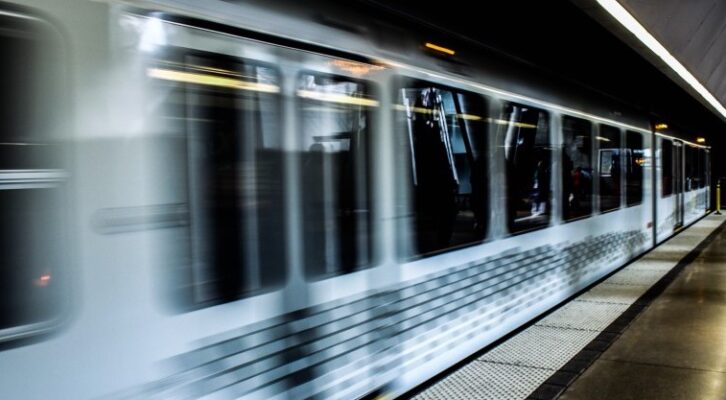
How a Train is Like a Novel: On the Phenomenon of Illusory Self-Motion
John Holten Considers the Mechanics of Movement on the Page and on the Tracks
Maybe you’ve had this experience: You’re sitting on a train, waiting for your departure— perhaps you were in a rush, impatient to reach your destination, or sad to be leaving behind a city and some of those in it—and then the train starts to slowly move, almost silently. As you begin to move, mentally and physically you exit the city and all that’s happened to you there.
Only then, in the next moment, you realize that you’ve not moved at all. The train next to you is the one moving. This sensation can be very powerful, and not a little disorientating. Its name is vection: an illusory self-motion in the absence of any actual bodily movement in space.
When looking around for a metaphor in which to wrap the desired effect on an imagined reader that a piece of fiction might create, vection seems almost suspiciously apt and neat. But let’s go with it all the same. Transportation, after all—as in this book is just so transportive—is the verb deployed when describing the state of being moved when sitting still with a book in one’s hands. A state of illusory self-motion though—I like that too.
The time given by the reader to a novel is a currency novelists can’t take for granted.
Europe’s train network, for instance, is a system representing progress, but also war, murder, and more recently, sustainability and hope. Timothy Morten’s outlining of hyperobjects, things so massively distributed in time and space that they “transcend spatiotemporal specificity” over the last decade seems to suggest a way to begin to think about the international train network—not least because Morten has suggested hyperobjects come into focus in times of ecological emergency or breakdown. Trains represent today both the history of industrial progress, and the fossil fuels that fed it, leading to the climate emergency, but now also the alternative to other transport that are worse for the environment.
Each European country has its own railroad histories, and like literary traditions and languages, each system can be seen to have helped forge burgeoning nations differently. Italy and Germany accelerated unification in the last decades of the 19th century and their train networks reached and linked up the different statelets and provinces that had previously existed in their place, while France’s radial system ensured Paris kept its prominence and central status over the outlying departments.
There’s something quaint about trains when one is considering them from the vantage point of the present, but their appearance in the landscape and in people’s lives was surely shocking, and wholly disruptive. Trains and their compartments were dangerous places and sources of anxiety, as was the very fact of facing your fellow passengers for hours at a time.
Emile Zola placed his story of madness and society’s descent into war atop the three-decade-old French train network in his 1890 novel La Bête humaine. The last scene of the novel is that of a runaway train, the imaginative manifestation of the murderous locomotive Lantier, filled with drunk soldiers singing on their way to fight the Prussians, is one of the most haunting endings of a novel you can read.
Two other masterful French examples of literary train journeys are The Modification by Michel Butor and Zone by Mathias Enard. The former takes place on a train going from Paris to Rome: one of the most popular nouveau romans it focuses in on details to tell the story of an affair. Enard’s book was his debut and playfully updated Butor’s. The translation into English by Charlotte Mandell was also the first book published by Fitzcarraldo Editions in London: these facts are all the more surprising when you consider that Zone comprises a single 517-page sentence. The rhythmic, amphetamine-addled thoughts of the narrator recount the recent histories of the countries touching the Mediterranean, the zone of the title. The stream of consciousness is delivered by Francis Mirković, a former mercenary, as he travels from Paris to Rome with a suitcase full of spy-goods is an endless well of memories and reveries and the savage acts of humankind.
Speaking of stream of consciousness: I can’t recall who reported it first, but by all accounts James Joyce picked up a copy of Édouard Dujardin’s Les Lauriers sont coupés in the Gare du Lyon while waiting for a train. The book would give him the inspiration for interior monologue. And while we’re here in a train station, passing the time until departure, we can also reflect on the fact that Allen Lane had an epiphany in Exeter train station. “I was returning from a weekend with Agatha Christie in the country, and running out of reading. Rather than buy a bad book at the station, I decided to start a publishing house.” The English paperback publishing enterprise par eminence, Penguin Books, whose mission it was to ensure commuters have something amusing to read on the train, was thus born.
All narrative is immersed in time and the novelist especially is constantly working in relation to time and its modalities.
Trains collapsed space and, in the process, standardized time. Rebecca Solnit’s masterful In The River of Shadows, a book about all manner of things from Edward Muybridge to the rise of Silicon Valley, outlines how train travel not only connected the continent of America and made barons like Stanford vastly wealthy, but that they also created the need for standardized time as they “annihilated time and space.”
And this creation of a standard time, unified and objective, is instructive. All narrative is immersed in time and the novelist especially is constantly working in relation to time and its modalities: whether that be choosing a tense in which to fire forth the action or dilating timespans or the running order itself. The Futurists loved the motion and speed of trains because they intuited that there was nothing more indicative of progress and innovation than the ever increasing speed of locomotion. And all art would have to catch up.
And even now, in a world of ravaged attentions, the time given by the reader to a novel is a currency novelists can’t take for granted. A train journey is no longer an uninterrupted time to get lost in a good book. Literary time and its experience, through illusory self-motion or otherwise, is one of the novel’s great, modern and yet slow, as in mindful, offerings.
The very first train engines were sealed up things—closed systems—and broke down because energy and its creation always results in something bursting forth, being spent, expended. Improving the earliest train engines led to the formulation of the second law of thermodynamics, which not only explained that absolutely everything in the universe is ultimately moving from a state of order into a cool, indifferent disorder, it also showed us how entropy rules everything, not least ourselves, and time moves in one direction only. The single biggest force to manipulate in the telling of any tale was there in all its ineluctable glory! All modern storytelling perhaps, from the novel to cinema to Tik Toks, has as its common thread an imperative to making anew the audience’s relationship to motion, speed and most of all, time’s arrow.
__________________________________

The Trains of Europe by John Holten is available from Broken Dimanche Press.
John Holten
John Holten is a novelist. His two novels The Readymades (2011) and Oslo, Norway (2015) were published by Broken Dimanche Press, which he co-founded in Berlin in 2009. In 2024 he published his third novel The Trains of Europe. His writing has been published in frieze, gorse, The Stinging Fly, and Electric Literature, among other places. Over the years he has collaborated with many visual artists with literary and text additions to their work, as well as exhibiting and performing his own visual, text and codex works in gallery settings.



















